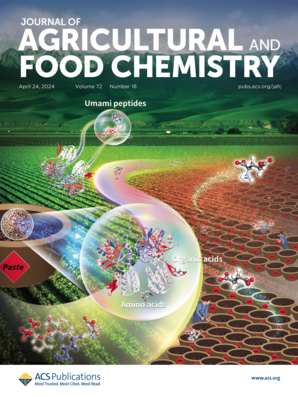Formation Patterns, In Vivo Toxic Effects, and Metabolomic Conditions of Oxidative Derivatives of Triolein.
IF 6.2
1区 农林科学
Q1 AGRICULTURE, MULTIDISCIPLINARY
引用次数: 0
Abstract
Oxidative derivatives of triacylglycerols (ox-TGs), complex compounds formed during the thermal processing of lipid-rich foods, have not been thoroughly investigated in terms of their formation patterns, structure-toxicity relationships, or toxicological effects. In this study, the oxidation pattern of triolein was examined through a heating model reaction, and the resulting compounds were analyzed using high-resolution mass spectrometry. The toxicological and metabolic effects of ox-TGs were further assessed in a 28-day subacute mouse model. It was found that heating triolein at 180 °C for 24 h predominantly generated the epoxy and peroxy derivatives. After 28 days of in vivo exposure, ox-TGs disrupted hepatic functions (AST/ALT increased to 3.35 ± 1.11 in males) and lipid metabolism (TG, HDL-C, and LDL-C decreased to 0.83 ± 0.19, 1.18 ± 0.21, and 0.25 ± 0.07 mmol/L, respectively, in females) (P < 0.05), with distinct gender-based differences in toxicological and metabolic responses. These findings provided insights into the oxidation behavior of triacylglycerols during food processing and revealed the potential toxicity mechanisms and target organs of ox-TGs. This study contributed to a better understanding of ox-TG formation and toxicity, offering a scientific basis for strategies aimed at reducing their presence in food.三油酸氧化衍生物的形成模式、体内毒性作用和代谢组学条件。
三酰基甘油的氧化衍生物(ox- tg)是在富含脂质的食物的热加工过程中形成的复杂化合物,在其形成模式、结构-毒性关系或毒理学效应方面尚未得到彻底的研究。在本研究中,通过加热模型反应考察了三油酸的氧化模式,并使用高分辨率质谱分析了所得化合物。在28天亚急性小鼠模型中进一步评估ox-TGs的毒理学和代谢作用。结果表明,三油酸在180℃下加热24 h,主要生成环氧衍生物和过氧衍生物。在体内暴露28 d后,ox-TGs破坏了肝脏功能(男性AST/ALT升高至3.35±1.11)和脂质代谢(女性TG、HDL-C和LDL-C分别降低至0.83±0.19、1.18±0.21和0.25±0.07 mmol/L) (P < 0.05),在毒理学和代谢反应上存在明显的性别差异。这些发现为研究食品加工过程中甘油三酯的氧化行为提供了新的思路,揭示了ox-TGs的潜在毒性机制和靶器官。这项研究有助于更好地了解氧化- tg的形成和毒性,为旨在减少其在食物中的存在的策略提供科学依据。
本文章由计算机程序翻译,如有差异,请以英文原文为准。
求助全文
约1分钟内获得全文
求助全文
来源期刊
CiteScore
9.90
自引率
8.20%
发文量
1375
审稿时长
2.3 months
期刊介绍:
The Journal of Agricultural and Food Chemistry publishes high-quality, cutting edge original research representing complete studies and research advances dealing with the chemistry and biochemistry of agriculture and food. The Journal also encourages papers with chemistry and/or biochemistry as a major component combined with biological/sensory/nutritional/toxicological evaluation related to agriculture and/or food.

 求助内容:
求助内容: 应助结果提醒方式:
应助结果提醒方式:


